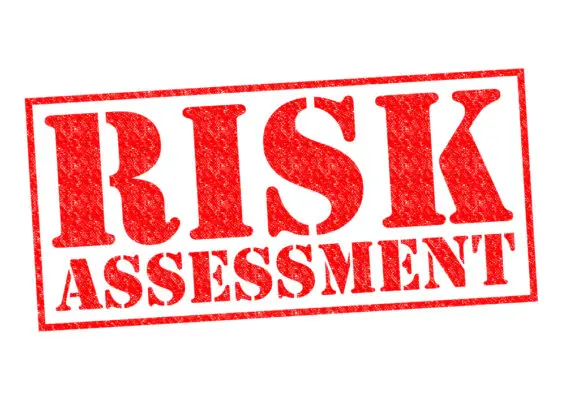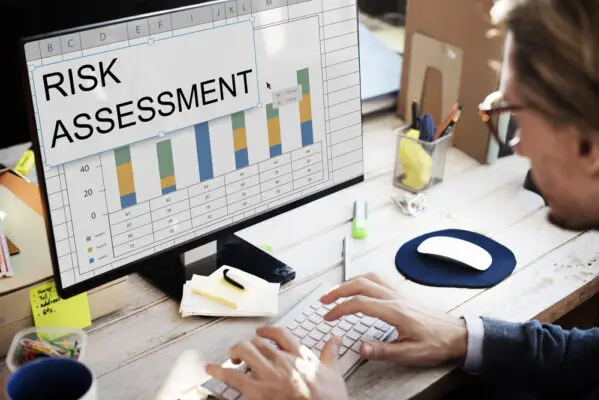Risk assessment tools are crucial in identifying, evaluating, and prioritizing risks in various sectors including business, health, safety, and environment.
These analytical tools aid in the systematic process of identifying potential hazards, determining who could be harmed, and assessing the severity of the potential harm.
A suitable risk assessment tool ensures accurate and efficient risk analysis. This article provides valuable insights into the different types of risk assessment tools, offering tips for selecting the most appropriate one.
Additionally, it explores other auxiliary tools that can be utilized with risk assessment tools.
The objective is to enhance understanding of these essential risk management tools, their applications, and how to maximize their benefits.
This information is integral for professionals in risk management, project managers, business executives, and anyone interested in understanding risk assessment mechanisms.

What are risk assessment tools?
Risk assessment tools refer to systematic methods employed in identifying potential hazards, quantifying the severity of potential outcomes, and determining the likelihood of their occurrence, thereby aiding in formulating strategic plans to mitigate these risks.
These tools generate risk scores, which assist in comparing and prioritizing various risks. Detailed risk assessments, often an integral part of these tools, delve deeper into each risk, revealing intricate details and predicting their potential impacts.
They are particularly vital in enterprise risk management, where they help in formulating robust strategies to counteract potential threats. Moreover, these tools offer security risk assessment, a crucial aspect in today’s digitalized environment.
Thus, with their systematic risk management methods, risk assessment tools play a pivotal role in ensuring the resilience and sustainability of organizations.
Tips for Choosing the right risk assessment tools
Selecting the most appropriate evaluation instruments for hazard analysis requires careful consideration of several factors including the nature of the project, the organizational context, and the desired level of detail in the results.
When choosing the right risk assessment tool, it is imperative to identify the potential risks and create an effective risk management strategy.
Here is a guide to some key factors to consider:
| Factor | Description | Example |
|---|---|---|
| Project Nature | The scope and complexity of the project | For a construction project, a tool that can assess physical risks is needed |
| Organizational Context | The environment in which the project will be implemented | For a project in a highly-regulated industry, a tool that can evaluate compliance risks is important |
| Detail Level | The amount of detail required in the results | A sophisticated tool that gives a comprehensive list of risks is crucial for high-stake projects. |
These tips for choosing the right risk assessment tools can help develop a robust risk mitigation plan.
Risk Assessment Tools
Risk assessment tools such as Isometrix, LogicManager, RM Studio, A1 Tracker, and Analytica are pivotal assets in identifying, analyzing, and managing potential risks within an organization.
These comprehensive software solutions facilitate a structured and systematic approach towards risk management, aiding in the decision-making process.
Each tool offers unique features and functionalities aimed at mitigating business risks, enhancing operational efficiency, and fostering a proactive risk management culture.
1. Isometrix
Harnessing the power of Isometrix in risk management can transform how organizations identify, assess, and mitigate potential threats, thereby fostering a safer and more secure operational environment.
As a sophisticated risk assessment tool, Isometrix offers a comprehensive solution for managing operational risk, ensuring business continuity and protecting critical business processes.
It integrates multiple data sources to provide a holistic view of an organization’s risk landscape.
The software’s advanced analytics capabilities enable the identification of potential hazards before they escalate, facilitating proactive mitigation strategies. With its ability to monitor and alert in real-time, Isometrix empowers organizations to respond promptly to emerging threats.
In essence, Isometrix is a robust shield, safeguarding businesses from the unpredictable nature of operational risks.
2. LogicManager
LogicManager is a prominent player in enterprise governance, empowering organizations with robust capabilities to manage their operational processes effectively.
The fundamental objective of LogicManager is to manage and reduce the risk level associated with business operations.
This platform extensively assesses cloud risks, enabling organizations to identify, analyze, and manage potential threats. With LogicManager, companies can visualize their current controls, identifying any loopholes or areas of vulnerability.
The tool offers a comprehensive, integrated approach to managing organizational risk, focusing on various financial, operational, and reputational risks.
It’s versatility and broad scope make LogicManager an invaluable tool for organizations aiming to enhance their risk management capabilities and promote sustainable growth.
3. RM Studio
Transitioning from the discussion on LogicManager, RM Studio is another prominent risk assessment tool that merits attention.
RM Studio is a comprehensive solution designed to facilitate businesses in identifying, assessing, and mitigating risks associated with their operations.
This tool is particularly effective in mapping business processes, thereby enabling organizations to pinpoint key process parameters that can potentially trigger risks.
One standout feature of RM Studio is its ability to conduct fault tree analysis, a systematic, deductive approach targeted at analyzing potential system failures. This feature of RM Studio aids in identifying root causes of risks, thus assisting organizations in developing robust risk mitigation strategies.
Therefore, with its extensive features and capabilities, RM Studio is an invaluable tool for businesses striving for effective risk management.
4. A1 Tracker
Continuing the discourse on risk management solutions, A1 Tracker emerges as a robust platform for businesses to stay ahead of potential threats and vulnerabilities.
This risk assessment tool offers comprehensive risk estimates to aid organizations in making informed decisions. It provides a baseline risk evaluation to predict the potential occurrence of risks.
| Features | Benefits |
|---|---|
| Comprehensive risk estimates | Enable informed decision making |
| Baseline risk evaluation | Predicts potential occurrence of risks |
| Identification of critical risks | Helps prioritize risk mitigation efforts |
A1 Tracker aids in identifying critical risks, allowing businesses to prioritize their risk mitigation efforts accordingly.
A1 Tracker offers organizations a comprehensive understanding of potential threats and vulnerabilities to help them proactively manage risks, thus increasing their resilience and ability to effectively respond to unforeseen events.

5. Analytica
Analytica is an influential platform for strategic decision-making in organizations, offering powerful quantitative modelling and analysis capabilities. It is a renowned risk assessment tool that utilizes the decision tree and fault tree diagram for evaluating potential failure effects.
This tree analysis feature provides a graphical and quantitative illustration of the risks involved, thus enabling a comprehensive understanding of potential drawbacks and benefits.
Analytica’s unique risk assessment approach helps organisations effectively identify risk for misconduct. Its robust model-building environment and intuitive influence diagrams facilitate the creation of complex models that capture uncertainties and interdependencies.
This advanced tool can handle many problems, from simple decision trees to intricate fault-tree diagrams. With Analytica, organizations can anticipate and mitigate risks, ensuring smooth operational flow and informed decision-making.
6. Resolver
In decision-making platforms, Resolver stands out as a comprehensive solution designed to streamline the identification and resolution of operational, third-party, and corporate security issues.
This risk assessment tool offers a unique blend of capabilities that transforms how criminal justice decisions are made by leveraging next-generation risk algorithms.
Resolver assists in establishing an effective justice system response by assessing the potential impacts of different decisions.
The platform’s robust features facilitate an efficient change control process, enabling organizations to navigate potential threats and mitigate risks more effectively.
Through detailed reporting and analytics, Resolver ensures that all stakeholders are well-informed about possible risks and the best strategies for their management.
This makes Resolver an indispensable tool in any risk management strategy.
7. Enablon
Shifting the focus to Enablon, one finds a sophisticated platform that revolutionizes how companies manage their environmental, health, and safety compliance requirements.
Enablon provides a comprehensive list of controls as a risk assessment tool, allowing organizations to meet regulatory demands effectively.
It incorporates robust documentation control procedures, ensuring all compliance-related documents are updated, accessible, and adhere to established guidelines.
Moreover, the platform embraces the Bowtie model of risk management. This model, characterized by its ability to visualize complex risk scenarios in a simple, understandable manner, adds significant value to the risk management process.
Therefore, it can be concluded that Enablon, with its advanced features and strategic approach, is transforming how organizations perceive and manage risks.
8. Isolocity
Transitioning to Isolocity, we encounter a platform that redefines the conventional approach to process management and quality control within organizations. As a risk assessment tool, Isolocity aids in predicting possible equipment failures and level failures, thereby ensuring product quality.
With the use of predictive analytics, it assesses potential risks in a systematic manner and offers data-based insights to aid in informed decision-making. Additionally, it streamlines operational efficiency by automating repetitive tasks, ultimately reducing the possibility of human error.
This automated risk assessment tool comprehensively views all organizational processes and potential vulnerabilities. Moreover, it allows for real-time tracking of quality metrics, providing a transparent view of product quality.
Consequently, Isolocity has positioned itself as an essential tool in identifying, managing, and mitigating risks within an organization’s operational framework.
Other Tools
The exploration of risk management is broad and varied, with many tools employed to identify, analyze, and evaluate potential hazards.
Key among these is the Risk Matrix, a grid-like tool used to determine risk levels by examining the likelihood of risk and its potential impact.
The Decision Tree is a diagram that outlines a range of potential outcomes and the probabilities associated with them.
The Failure Modes and Effects Analysis (FMEA) is a step-by-step approach for identifying all possible failures in a design, a manufacturing or assembly process, or a product or service.
The Bowtie Model visually demonstrates all plausible scenarios that could lead to a particular hazard.
Each tool offers a unique perspective and method for assessing risk, thereby contributing to a comprehensive and robust risk management strategy.
1. Risk Matrix
A Risk Matrix is vital in risk assessment tools, providing a visual representation of potential hazards based on their likelihood and severity.
This tool can help criminal justice agencies to identify potential issues and prioritize their responses, contributing to justice system reforms.
The matrix allows for a systematic approach to risk assessment, which is crucial in managing limited justice resources. Considering both the probability and impact of risk provides a comprehensive view of potential threats and their implications.
Institutions such as the MDRC Center for Criminal Justice Research have emphasized the importance of the Risk Matrix in effective decision-making processes within the justice system. Therefore, its use can support informed, efficient, and equitable justice practices.
2. Decision Tree
Amidst the vast array of strategic planning instruments, the Decision Tree is an exceptional method for dissecting complex problems within the criminal justice system.
As a risk assessment tool, it graphically represents possible alternatives to a current situation, their probabilities of occurrence, and their potential impacts.
| Decision Tree Node | Interpretation | Regulatory Impact |
|---|---|---|
| Decision Node | Represents a point of decision | Regulatory impact depends on the choice made |
| Chance Node | Reflects uncertain events | The regulatory impact depends on the choice made |
| End Node | Shows possible outcomes | Final regulatory impact based on cumulative decisions |
This tool aids in determining acceptable levels of risk and regulatory impact, thus providing a structured approach to decision-making. The decision tree can significantly improve the transparency and understanding of the decision-making process.
3. Failure Modes and Effects Analysis (FMEA)
Examining the potential vulnerabilities of a process, product, or system within the criminal justice system is made feasible through Failure Modes and Effects Analysis (FMEA).
This risk assessment tool provides a systematic approach to identifying and addressing potential failure modes before they occur, thereby enhancing the reliability and safety of operations.
In a healthcare organization, FMEA can be used for hazard identification and risk estimation, minimising potential environmental impacts and contamination issues.
It involves examining potential failure points in processes and systems, the causes of these failures, and their potential effects.
FMEA plays a crucial role in managing risks and enhancing the overall effectiveness and safety of operations by anticipating and minimizing potential risks. Therefore, it is a valuable tool for risk management.
4. Bowtie Model
In safety management, the Bowtie Model emerges as a visual and interactive approach to comprehending and managing potential threats within the criminal justice system.
This risk assessment tool uses a human model to graphically represent a scenario where a hazardous event occurs, outlining the cause and consequence.
The ‘knot’ of the bowtie signifies the critical event, with the left side depicting preventive measures and the right illustrating mitigative measures.
The model’s strength lies in its ability to integrate dynamic and characterization factors into one comprehensive diagram, enabling in-depth analysis of various risk scenarios.
This visual representation not only facilitates understanding but also aids in devising effective and efficient risk control measures, making the Bowtie Model an invaluable device in safety management.
Frequently Asked Questions
What are the costs associated with implementing risk assessment tools in an organization?
Implementing risk assessment tools in an organization incurs costs such as purchase or subscription of the tool, staff training, periodic maintenance, potential system upgrades, and time investment for integration and regular usage.
How often should risk assessment tools be updated or reviewed for effectiveness?
The frequency of updating or reviewing the effectiveness of assessment tools depends on numerous factors. However, best practice suggests reviewing at least annually or whenever significant changes occur within the organization’s operations or environment.
Are there specific training requirements for employees to effectively use these tools?
Training requirements for the effective use of such tools often include understanding the tool’s functionality and application. Regular training updates are crucial as these tools often undergo revisions to maintain effectiveness and relevance.
Can risk assessment tools be integrated with other existing systems within the organization?
Yes, the integration of risk assessment tools with other existing systems within an organization is feasible. This interoperability enhances efficiency, streamlines processes, and allows for comprehensive risk analysis and management.
What are the common challenges or problems faced when implementing risk assessment tools?
Common challenges in implementing risk assessment tools include lack of understanding, inadequate training, resistance to change, integration issues with existing systems, time and resource constraints, and difficulty quantifying certain risks.

Conclusion
To wrap things up, risk assessment tools are crucial for identifying and assessing potential dangers in different industries in a methodical manner.
Selecting suitable tools necessitates carefully considering their features and applicability to specific contexts.
Utilizing such tools promotes a proactive approach to risk management, fostering a safer and more efficient operational environment.
Furthermore, their integration into routine practices can significantly enhance the efficacy of preventive measures and contingency planning.

Chris Ekai is a Risk Management expert with over 10 years of experience in the field. He has a Master’s(MSc) degree in Risk Management from University of Portsmouth and is a CPA and Finance professional. He currently works as a Content Manager at Risk Publishing, writing about Enterprise Risk Management, Business Continuity Management and Project Management.

